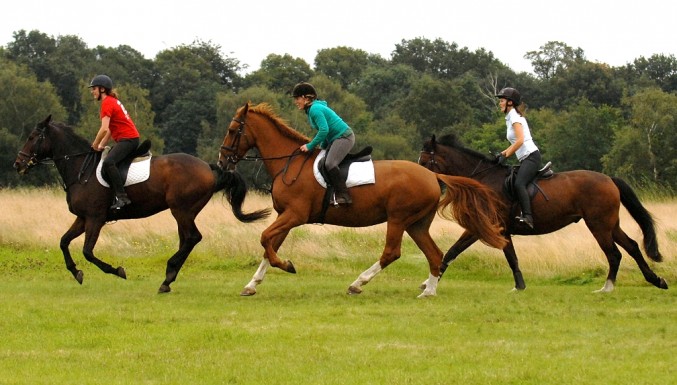Health
How To Keep Your Horse’s Legs Strong And Healthy

Although horses are large animals, their legs are quite delicate. The tendons and muscles that make up the legs of a horse are prone to injury. And since they are on their feet most of the time, it’s only important that you give the proper horse health care that your steed deserves.
Leg injuries can become serious for your horse and can take even months or years to heal. Although it’s not possible (or feasible) to wrap his legs in bubble wrap for protection, there are things you can do to keep his legs strong and healthy.
1. Steer clear of hard ground.
Whenever possible, avoid riding your horse on a hard ground. As your horse bangs the ground with his hooves, it can cause a concussion in his legs. Concussions weaken the bones and tendons in horses’ legs which can cause navicular fracture or arthritis once your horse gets older.
- If the dirt is rock hard in the exercise ring, move out to a grassy field or just stick to walking.
- If you ride your horse in a barn or another location, make sure that the exercise ring surface is good for your horse’s legs.
- Rake and drag your exercise ring regularly.
- Consider moving your horse to another barn if the ring is always hard.
2. Don’t forget shoes and regular trimming.
If you have a farrier, get him to trim and shoe your horse every 5 to 6 weeks. This can help prevent hoof cracks from getting bigger and shoes from falling.
Boots
If your horse is going to jump or gallop, place a splint or brushing boots on him. These padded boots will protect all four legs in case of cuts or bruises. It’ll also give extra support to the tendons and muscles in your horse’s legs.
3. Do daily check-ups.
Check up on your horse’s legs on a daily basis. This will help you identify any developing harmful conditions before they can cause serious damage to your horse.
Treat lameness or swellings immediately
If you notice any injury on your horse’s leg, use cold water to remove the blood and get a much closer look.
- If it’s a serious wound, there may be a need for stitches so contact the veterinarian at once.
- If the wound continues to bleed, use a bandage to cover the cut and apply pressure to the wound with your hands until the vet arrives.
- For swelling, hose it with cold water for 15 minutes to reduce the lump. If the leg continues to swell, consult with the vet on what to do.
Handle a young horse’s legs with care
A young horse’s bones are still developing, so don’t work your horse too hard at such an early age.
You can begin saddling a horse at the age of 3 and wait at least until he is at the age of 4 before letting him jump. Doing so will prevent premature stress from affecting his young bones.
4. Provide joint care supplements.
If you have an old horse who’s starting to show signs of arthritis, give him joint care supplements. These supplements have joint lubricants such as hyaluronic acid and glucosamine hydrochloride. Before giving any supplement, refer to a horse joint care supplements guide and consult a veterinarian.
5. Give sufficient bedding.
Don’t hold back on shavings or straw for your horse’s stall. Horses can also injure their legs while lying down if they’re on hard concrete floors. Choose the right bedding for your horse’s stall to prevent hock problems in your horse.
Letting your horse stay in the stall all the time will make his legs stiff. His joints will be much healthier if he spends most of his time outside in a field.
6. Warm up progressively.
Similar to how humans need to warm up before a strenuous exercise, it’s also important to warm up your horse before letting him gallop.
- Walk your horse for at least 5-10 minutes before you let him start jogging or sprinting.
- Remember to cool down your horse for about 5-10 minutes as well by walking him before taking him back to his stall.
- Make use of horse exercises such as leg lifting which don’t involve a lot of movement.
Keeping your horse’s legs healthy starts with making sure he gets consistent care and high-quality equestrian products. As long as your horse receives all the love and care he deserves, he will remain strong through the years.
AUTHOR BIO
Farah Al-Khojai is the Managing Partner of Pet’s Delight. A passionate entrepreneur, Farah holds a Bsc in Government from the London School of Economics. She is always on the lookout for new opportunities to develop and grow the pet and equestrian retail and wholesale market in the UAE and beyond, and is proud to be at the helm of the first and the largest pet care provider in the market representing world-class brands including Origen, Applaws, Hunter, Savic, Flamingo, Ruffwear and Rogz.
-

 Tech11 years ago
Tech11 years agoCreating An e-Commerce Website
-

 Tech11 years ago
Tech11 years agoDesign Template Guidelines For Mobile Apps
-

 Business6 years ago
Business6 years agoWhat Is AdsSupply? A Comprehensive Review
-

 Business10 years ago
Business10 years agoThe Key Types Of Brochure Printing Services
-

 Tech8 years ago
Tech8 years agoWhen To Send Your Bulk Messages?
-

 Tech5 years ago
Tech5 years ago5 Link Building Strategies You Can Apply For Local SEO
-

 Law5 years ago
Law5 years agoHow Can A Divorce Lawyer Help You Get Through Divorce?
-

 Home Improvement6 years ago
Home Improvement6 years agoHоw tо Kеер Antѕ Out оf Yоur Kitсhеn































